
by Matt Lollar | Jan 2, 2025
It’s a new year and if you’re still contemplating resolutions, here’s one for you. Stay organized with your vegetable planting schedule. Since it’s January, let’s start with what you can do now. Crops like beets, broccoli, and Brussels are best planted as transplants in January. But carrots and celery can be started from seed and potatoes can be planted as seed potatoes, which are usually pieces of potato tubers containing at least 3 buds (eyes). January is also a good time to start transplants indoors for the spring garden. Tomato and pepper transplants can be planted in the garden as early as February or March depending on the year. If all this planting talk is overwhelming, then at least consider collecting and mailing off a soil sample for nutrient analysis. More information on soil testing can be found on askIFAS. This will give you a head start on adjusting pH with lime and improving soil health with compost and other organic materials. To help plan this “Year of the Vegetable Garden” please click below to enlarge the image of the handy “Florida Panhandle Planting Guide”.
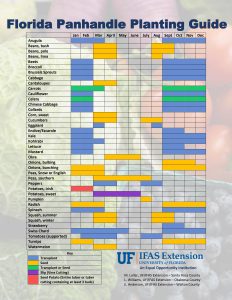
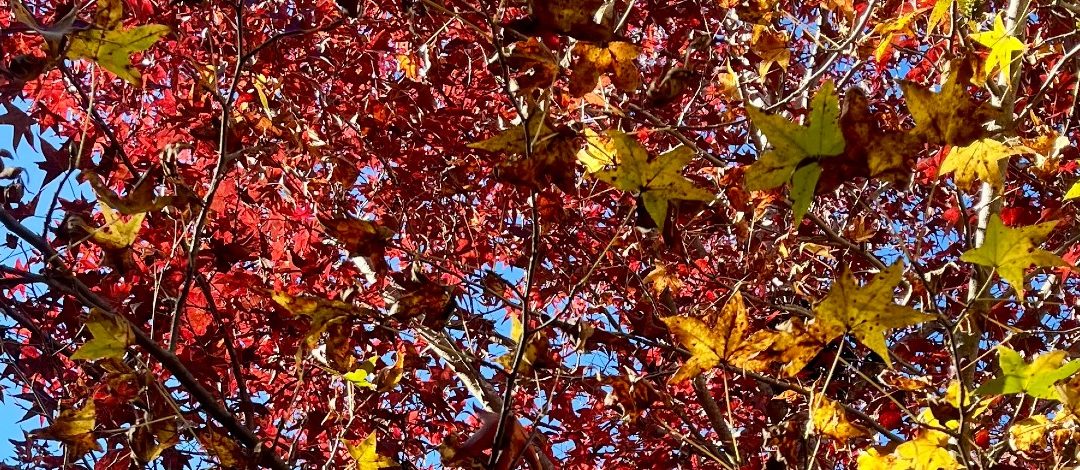
by Larry Williams | Jan 2, 2025
In the Christmas story as recorded in the book of Matthew, wise men presented gifts to baby Jesus. Two of these gifts were frankincense and myrrh. These are costly perfume oils derived from certain trees found in parts of the Middle East.
According to Dr. Kim Coder, urban forestry specialist with the UGA Extension Service, there are more than 36 trees mentioned throughout the Old and New Testaments. Some of these trees have relatives living here in Florida.
In an article on this topic, Coder said, “The trees most people think of from the Bible are the Cedars of Lebanon.” Lebanon cedars are true cedars like the Deodar cedar found planted in some North Florida communities. He said, “Today a relict (species of an earlier time) grove of 400 trees still survives on Mount Lebanon that is more than 2000 years old.”
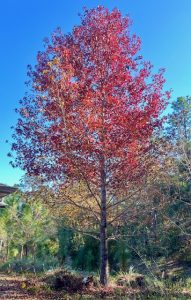
Sweetgum tree fall foliage at Okaloosa County Extension Office. Credit: Larry Williams
The sycamore common to North Florida does not grow in Palestine. “The sycamore of the Bible is the sycamore fig,” Coder explained. The fruit of the sycamore fig is smaller and less sweet as compared to the table fig and was considered food for the poor. Another name used by some people in the United States for sycamore is plane tree but Coder said that the plane trees referred to in the Bible were the flowering viburnums and oriental plane trees in the Middle East. “Also mentioned is the sycamine, which is the black mulberry,” Coder said.
The poplar trees of the Bible are the same white poplar that you can find growing in some areas of North Florida but it is more commonly found north of Florida. “But poplar also means
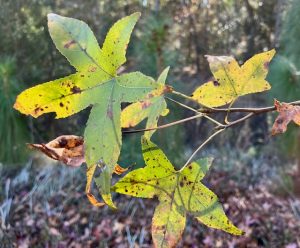
Sweetgum star-shaped leaves in fall. Credit: Larry Williams
snowbell, which is related to our native snowbells,” Coder said. “The name poplar was used for two distinctly different trees.”
One tree from the Bible that is common in North Florida is balm. “The balm, or balm of Gilead, was the sweetgum tree,” Coder said. The sweetgum of the Middle East is almost identical to our sweetgum tree that grows all over North Florida. Coder said that there is a tree named “Balm of Gilead” that grows in the northern United States but it is native only to North America. “Our sweetgum is a botanical link to the sweetgum of the Bible,” he said.
Ebony wood, which is also mentioned in the Bible, was imported for carvings and decorations. “Ebony is related to our common persimmon,” Coder said.
Florida’s forests are filled with close relatives of a number of Biblical trees. “There are many links to our cultural heritage stemming from the Bible,” Coder said. “Touch a sweetgum leaf and you hold a piece of Christian and Jewish history.”
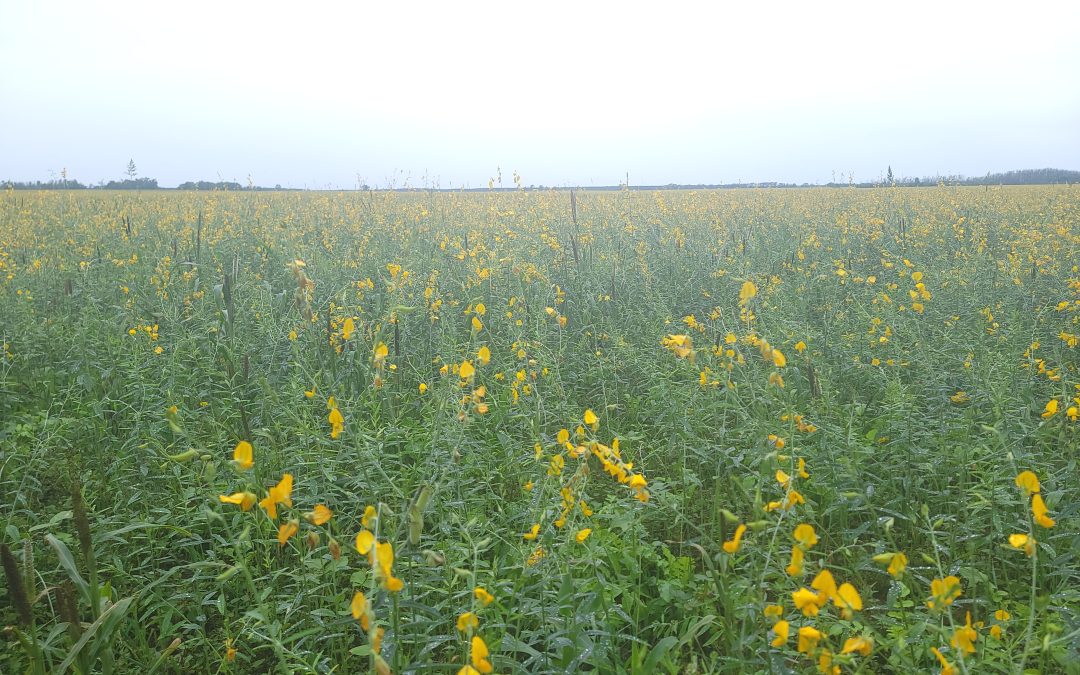
by Joshua Criss | Nov 21, 2024
A Sea of Yellow
You do not often see a sea of yellow flowers on what was recently a field of row crops in North Florida. In this instance, the culprit is a cover crop called sunn hemp (Crotalaria juncea). Cover cropping, or green manure as it is sometimes known, is not a new concept. It is a great method for improving soil quality, adding organic matter, augmenting nitrogen supply, supporting pollinators when resources begin to wane, and combating nematodes. Incorporating this sustainable agriculture practice into home vegetable gardens is an excellent method to build long-term viability and production.
Many plants may be used in this capacity, but this article will focus on sunn hemp. This annual is an herbaceous, short-day flowering plant in the Lamiaceae or legume family. Its erect stems produce a great deal of biomass and, as a legume, will augment nitrogen stores within your soil profile. As if that wasn’t enough to sell you, this plant is also known to suppress nematode populations. Native to India and Pakistan, where sunn hemp is grown for fiber, this plant grows well in tropical and temperate environments. It will thrive in even sub-par conditions and requires little fertilizer input.
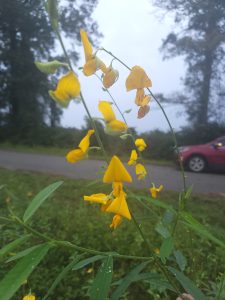
UF/IFAS Photo: Josh Criss
Seed Time
Seed this plant once your summer gardens have begun to wane. The shorter day length will keep the plant confined to about 3-4 feet while still allowing it to flower. It may also be planted earlier in the year to maximize below-ground biomass and add organic matter. In this scenario, the plant will likely grow to 7 feet tall with a closed canopy within 10 weeks.
Sunn hemp requires little fertilization as it is a legume, a plant family known to fix nitrogen from the atmosphere. This same mechanism is one of the features of this plant as a cover or green manure crop, as it can add up to 320 pounds of nitrogen per acre back to the soil when planted en masse.
Seeding rates within a home garden are much smaller. A farmer may plant 30-50 pounds of seed, which is not practical in small-scale growing. Instead, aim to cover the garden area through broadcasting seed, as a denser planting will reduce the later branching of this plant. Ensure you have 8-12 weeks of warm, frost-free weather, and terminate them prior to reaching the full bloom stage. Doing so will provide your gardens with the same benefits seen in farm fields utilizing this sustainable practice.
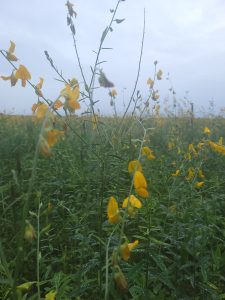
UF/IFAS Photo: Josh Criss
To Sum it Up
Sunn hemp is an excellent plant for your gardens before your fall greens. The biomass it produces and the nitrogen it recovers make it very attractive to farmers and should raise eyebrows even in the home garden. The trick is learning to manage this plant within your crop rotation. For more information on soil management refer to these IFAS documents, or contact your local extension agent for additional information on this and any topic regarding your gardens and more.
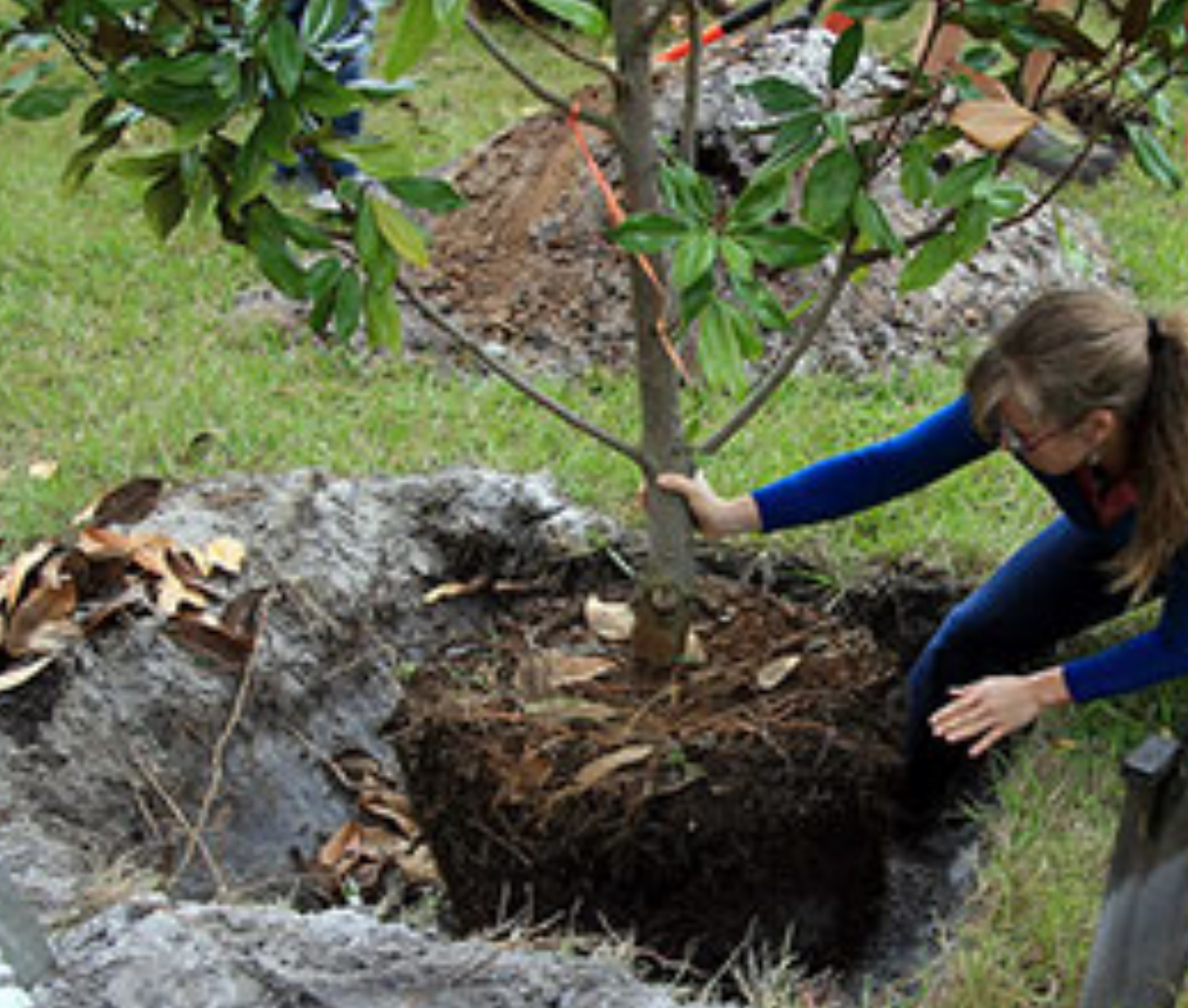
by Matt Lollar | Nov 13, 2024
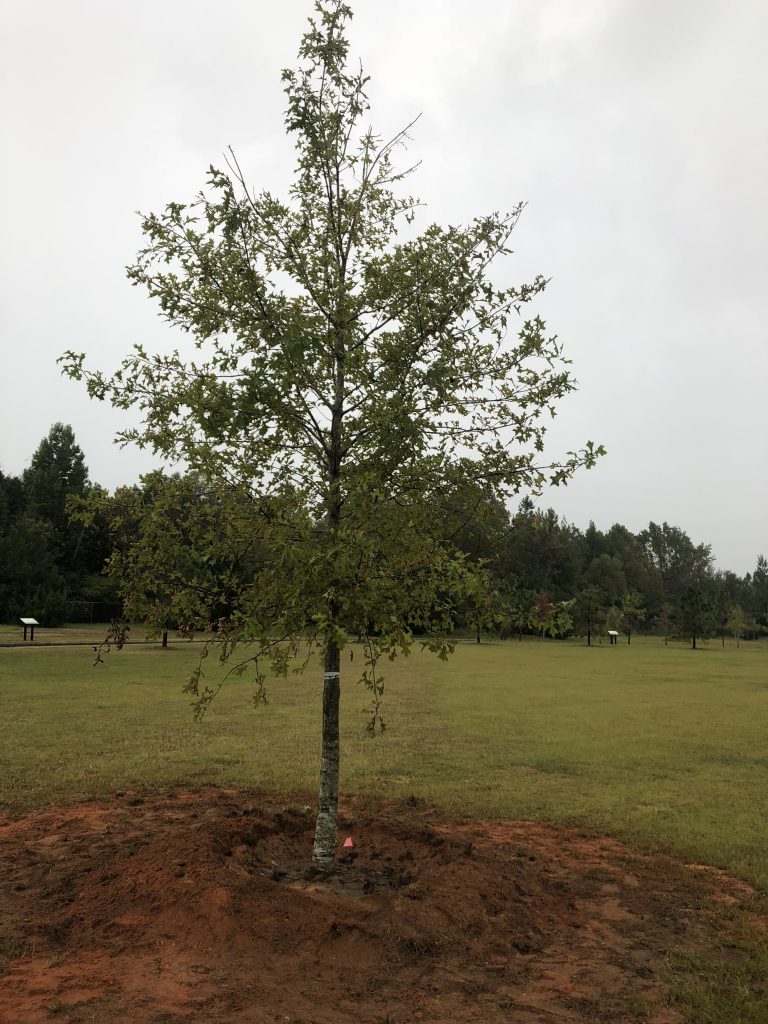
A planted tree with water retention berm. Photo Credit: Matt Lollar, University of Florida/IFAS Extension – Santa Rosa County
Extension agents are frequently tasked with evaluation of unhealthy plants in the landscape. They diagnose all sorts of plant problems including those caused by disease infection, insect infiltration, or improper culture.
When evaluating trees, one problem that often comes to the surface is improper tree installation. Although poorly installed trees may survive for 10 or 15 years after planting, they rarely thrive and often experience a slow death.
Fall is an excellent time to plant a tree in Florida. A couple of weeks ago beautiful Nuttall Oak was planted at Bagdad Mill Site Park in Santa Rosa County, FL. Here are 11 easy steps to follow for proper tree installation:
- Look around and up for wire, light poles, and buildings that may interfere with growth;
- Dig a shallow planting hole as wide as possible;
- Find the point where the top-most root emerges from the trunk;
- Slide the tree carefully into the planting hole;
- Position the point where the top-most root emerges from the trunk slightly above the landscape soil surface;
- Straighten the tree in the hole;
- Remove synthetic materials from around trunk and root ball;
- Slice a shovel down in to the back fill;
- Cover the exposed sides of the root ball with mulch and create water retention berm;
- Stake the tree if necessary;
- Come back to remove hardware after establishment.
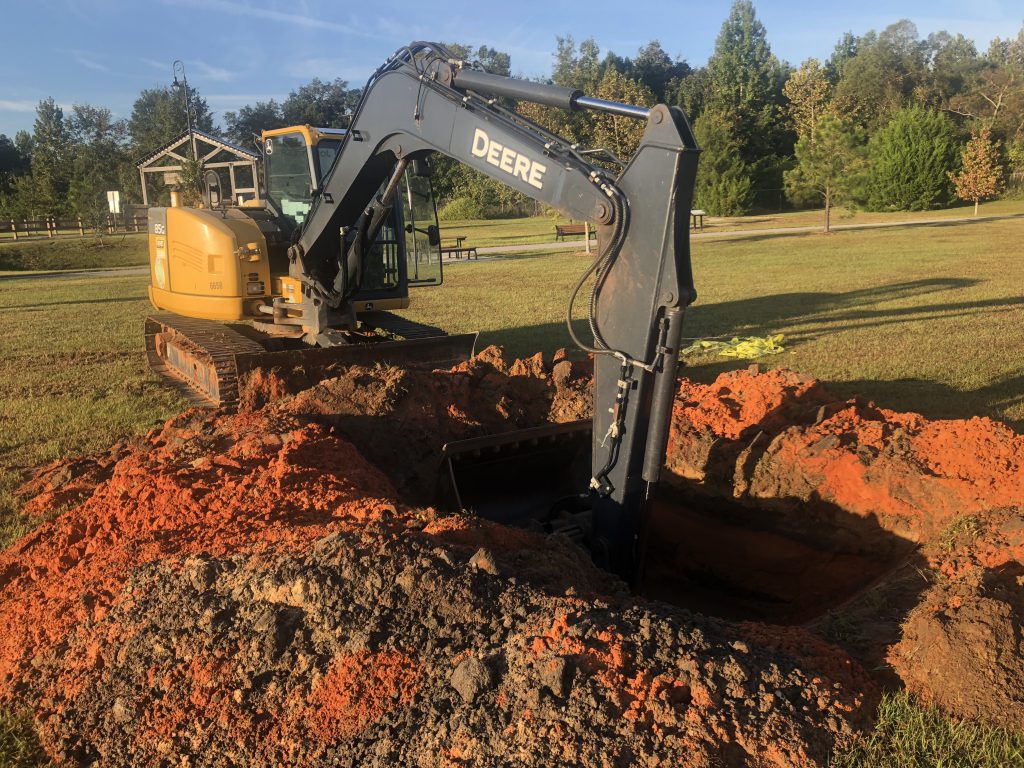
Digging a properly sized hole for planting a tree. Photo Credit: Matt Lollar, University of Florida/IFAS Extension – Santa Rosa County
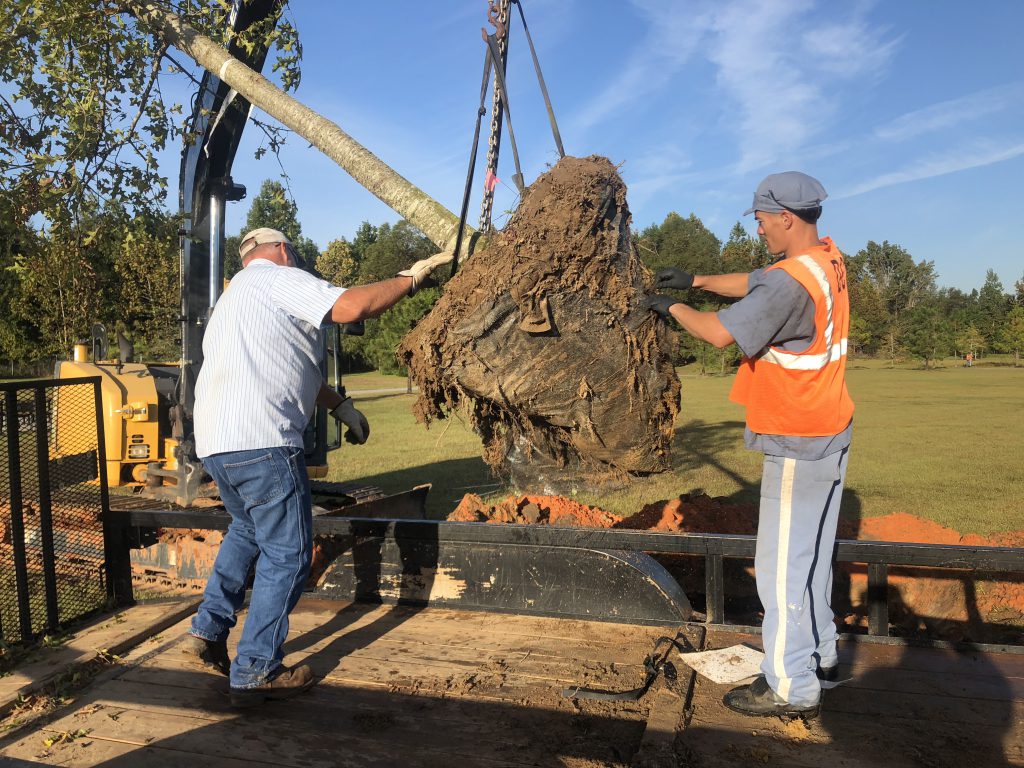
Removing synthetic material from the root ball. Photo Credit: Matt Lollar, University of Florida/IFAS Extension – Santa Rosa County
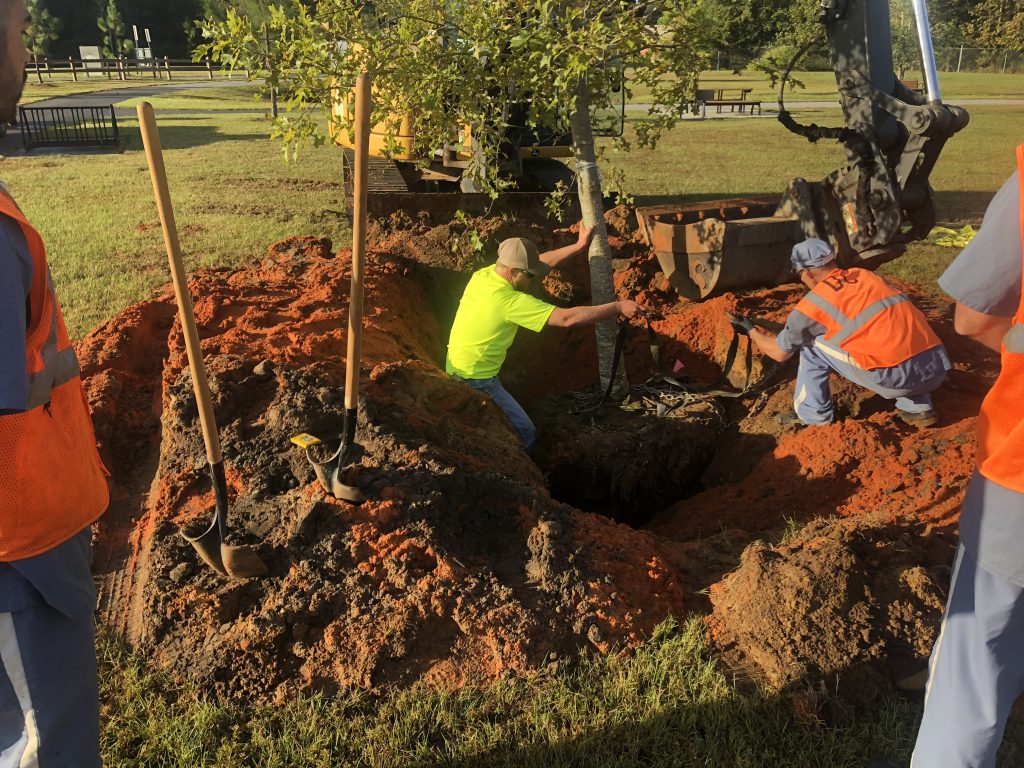
Straightening a tree and adjusting planting height. Photo Credit: Matt Lollar, University of Florida – Santa Rosa County
For more detailed information on planting trees and shrubs visit this UF/IFAS Website – “Steps to Planting a Tree”.
For more information Nuttall Oaks visit this University of Arkansas Website.
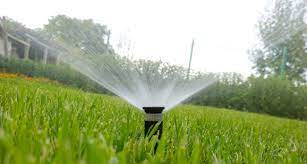
by Matt Lollar | Oct 8, 2024
On a recent family walk, I noticed something pretty obvious. One of our neighbors had a broken irrigation head. Luckily this is an easy fix, because a new rotor can just be screwed into place. But seeing the amount of water running into the street got me thinking about some additional ways to save water. Scroll down for some water saving tips based on the 9 Principles for Florida Friendly Landscaping.
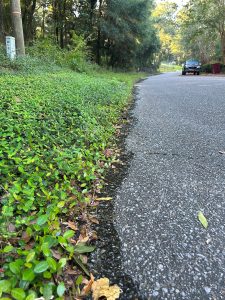
Water runoff from a broken irrigation head. Photo Credit: Matt Lollar, University of Florida/IFAS Extension – Santa Rosa County
4 Ways to Save Water
- Pick the right plant for the right place. Turf is an excellent choice for catching runoff in the situation pictured above. However, it’s important to evaluate your yard based on the amount of sunlight received throughout the day. Once you’ve determined if you need sun loving, shade loving, or plants that can handle a little of both, you’ll want to check how well your soil drains. Some plants can handle wet conditions better than others. Use the FFL Plant Guide to help pick the plants for your space.
- Irrigate based on plant requirements. Plants like to be watered thoroughly to the extent of their rootzones. For turf, we recommend irrigating deeply and infrequently early in the morning. This method encourages the roots to grow deep to reach the water needed. Most established trees and shrubs don’t need supplemental irrigation unless we’re going through an extended period of drought. Review the Summary of Turf and Landscape Irrigation Recommendations to help determine the amount of water your yard needs.
- Calibrate the irrigation system. If you have an irrigation system, then you need to make sure it’s calibrated. To do this, you’ll first need to make sure your system doesn’t have any leaks or broken heads and redirect heads to water plants instead of the driveway, sidewalk, or road. Next, you’ll need to determine how long to run your system based on water output. The run time test is detailed on the UF/IFAS Calibrating Your Irrigation System webpage.
- Use mulch around trees and shrubs. Mulch can help hold moisture and conserve water. It’s important to keep mulch to between 2 and 3 inches deep and at least 2 inches away from the base of trees and shrubs. There’s a lot more information on Choosing and Installing Mulches on the Gardening Solutions website.
Following these simple tips will ensure that you’re watering efficiently and effectively. If you have additional questions about irrigation or just about anything plant related, please contact your local UF/IFAS Extension Office.















